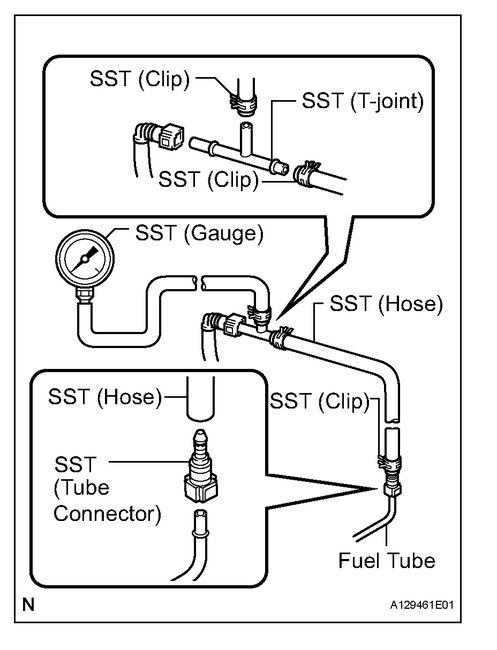Welcome to 2CarPros.
I agree with you that it is a fuel related issue. With that, I would first start with checking fuel pressure. Here is a link that shows how it is done:
https://www.2carpros.com/articles/how-to-check-fuel-system-pressure-and-regulator
Here are the specific directions for your vehicle. The pressure specs are included in the directions, and the attached picture correlates with these directions.
________________________________________
COMPONENT TESTS AND GENERAL DIAGNOSTICS
ON-VEHICLE INSPECTION
1. CHECK FOR FUEL PUMP OPERATION AND FUEL LEAKS
a. Check fuel pump operation.
1. Connect the intelligent tester to the DLC3.
2. Turn the ignition switch on (IG) and push the intelligent tester main switch on.
NOTE: Do not start the engine.
3. Select the following menu items: DIAGNOSIS / ENHANCED OBD II / ACTIVE TEST / FUEL PUMP / SPD.
4. Check for pressure in the fuel inlet tube from the fuel line. Check that sound of fuel flowing in the fuel tank can be heard. If no sound can be heard, check the integration relay, fuel pump, ECM and wiring connector.
b. Check for fuel leaks.
1. Check that there are no fuel leaks anywhere on the system after performing maintenance. If there is a fuel leak, repair or replace parts as necessary.
c. Turn the ignition switch off.
d. Disconnect the intelligent tester from the DLC3.
2. CHECK FUEL PRESSURE
a. Discharge the fuel system pressure
b. Using a voltmeter, measure the battery voltage.
Standard voltage: 11 to 14 V
c. Disconnect the negative (-) battery terminal.
d. Disconnect the fuel hose from the fuel main tube.
picture 1
e. Install SST (pressure gauge) using SST and a fuel tube connector as shown in the illustration.
SST 09268-31011 (09268-41500, 90467-13001, 95336-08070), 09268-45014 (09268-41200, 09268-41220, 09268-41250)
f. Wipe up any gasoline.
g. Connect the negative (-) battery terminal.
h. Connect the intelligent tester to the DLC3.
i. Select the following menu items: DIAGNOSIS / ENHANCED OBD II / ACTIVE TEST / FUEL PUMP / SPD.
j. Measure the fuel pressure.
Fuel pressure: 304 to 343 kPa (3.1 to 3.5 kgf/sq.cm, 44.1 to 49.7 psi)
- If the fuel pressure is greater than the standard value, replace the fuel pressure regulator.
- If the fuel pressure is less than the standard value, check the fuel hoses and connections, fuel pump, fuel filter and fuel pressure regulator.
k. Disconnect the intelligent tester from the DLC3.
l. Start the engine.
m. Measure the fuel pressure at idle.
Fuel pressure: 304 to 343 kPa (3.1 to 3.5 kgf/sq.cm, 44.1 to 49.7 psi)
n. Stop the engine.
o. Check that the fuel pressure remains as specified for 5 minutes after the engine stops.
Fuel pressure: 147 kPa (1.5 kgf.sq.cm, 21 psi) or more
If the fuel pressure is not as specified, check the fuel pump, pressure regulator and/or fuel injectors.
p. After checking the fuel pressure, carefully disconnect the negative (-) battery cable, and remove the SST and fuel tube connector to prevent gasoline from splashing.
q. Reconnect the fuel tube to the main fuel tube (fuel tube connector).
r. Install the No. 1 fuel pipe clamp to the fuel tube connector.
s. Check for fuel leaks (step 1)
______________________________________
Let me know what you find or if you have other questions.
Joe
Image (Click to make bigger)
Monday, February 22nd, 2021 AT 8:45 AM




